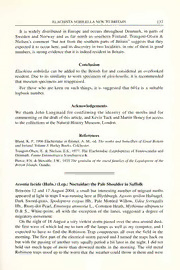
Acontia lucida (Hufn.) (Lep.: Noctuidae) the pale shoulder in Suffolk PDF
Preview Acontia lucida (Hufn.) (Lep.: Noctuidae) the pale shoulder in Suffolk
ELACHISTANOBILELLANEWTOBRITAIN 137 It is widely distributed in Europe and occurs throughout Denmark, in parts of Sweden and Norway and as far north as southern Finland. Traugott-Olsen & Nielsen's comment "but not from the southern parts of Britain" suggests that they expected it to occur here, and its discovery in two localities, in one ofthem in good numbers, is strongevidence that it is indeedresident in Britain. Conclusion Elachista nobilella can be added to the British list and considered an overlooked resident. Due to its similarity to worn specimens ofgleichenella, it is recommended that museum specimens are reappraised. For those who are keen on such things, it is suggested that 601a is a suitable logbook number. Acknowledgements We thank John Langmaid for confirming the identity of the moths and for commenting on the draft ofthis article, and Kevin Tuck and Martin Honey foraccess to thecollections at the Natural History Museum, London. References Bland, K. P., 1996 Elachistidae in Emmet. A. M., ed. The moths andbutterflies ofGreatBritain andIreland. Vohime3. Harley Books,Colchester. Traugott-Olsen, E. & Nielsen, E.S., 1977. The Elachistidae (Lepidoptera) of Fennoscandia and Denmark.FaunaEntomologicaScandinavica6. Pierce, F.N. & Metcalfe, J.W.. 1935 The genitalia ofthe tineidfamilies ofthe Lepidoptera ofthe BritishIslands. Oundle. Acontialucida (Hufn.) (Lep.: Noctuidae) thePale Shoulderin Suffolk Between 12 and 17 August 2004, a small but interesting number of migrant moths appeared at light in traps I was running here at Blythburgh. Agrotis ipsilon Hufnagel, Dark Sword-grass, Spodoptera exigua Hb., Pale Mottled Willow, Udeaferrugalis Hb., Rusty-dot Pearl, Ematurga atomaria L., Common Heath, Mythimna albipuncta D.& S., White-point, all with the exception of the latter, suggested a degree of migratory movement. On the night of 18 August a very violent storm passed over the area around dusk, the first wave of which led me to turn off the lamps as well as my computer, and I expected to have to find the Robinson Trap components all over the field in the morning. The first part ofthe electrical storm passed and I turned the traps back on but with the passing ofanother very squally period a bit later in the night, I did not hold out much hope of more than drowned moths in the morning. The old metal Robinson traps stood up to the worst that the weather could throw at them and were — 138 ENTOMOLOGIST'SRECORD, VOL. 117 25.V.2005 intact and almostbone dry inside in the morning. On top ofthe firstegg carton that I looked at was an Acontia lucida (Hufn.), the Pale Shoulder. There followed something of a frantic chase through the trap before this moth was boxed. There werefew othermoths and nothing ofmigratory interest inthe traps. On 19 August, moths such as M. albipuncta, Nomophila noctuella D.& S. the Rush Veneer, A. ipsilon Hufn. and E. atomaria (four specimens) came to light. Mythimna albipuncta D.& S. is so common here over such a long period that I am unable to differentiate between resident and possible immigrant specimens, even though there are some interesting colour variants. On 24 August there were about twentyE. atomaria inthe traps. I have heard ofseveral records ofA. lucida from the south coast in 2004, but this seems to be first sighting on the east coast as well as a new record for Suffolk. DavidWilson, Lark Rise, Dunwich Road, Blythburgh, Suffolk IP19 9LT. Stillfurtherthoughts on The Continentcutoffbyfog Following my further thoughts on The Continent cut off by fog' {antea 88-90), I have received a most helpful letter from Harry E. Beaumont of Rotherham, South Yorkshire. I asked for information regarding the curious labels placed with specimens in the Douglas Harrison collection ofBritish moths. MrBeaumont writes: 'The labels were published as A label list ofBritish Macro-lepidoptera by the AES as their pamphlet No. 4, dated 1946, which ran to 32 pages and was printed by T. Buncle & Co. of Arbroath. The authors were Mr B. A. Cooper and Mr A. F. O'Farrell who state in their introduction that scientific names from two sources are given, the first are names used in the BM(NH) based largely on the most recent edition of"South" and the secondthose used in the Kloet & Hincks (1945) Checklist ofBritish Insects. Where the two agree only a single name is printed. They go on to say that two English names are also given, the first are the proposed revised names ofthe authors and the second the names usedby South. The authors go on to express the hope that the former will gradually supersede the latter. The cover price of the list is 3/6d, but by the time I obtained my copies (late 1950s or early 1960s) they were presumably already regarded as outdated as they cost me one shilling percopy. One I cut up and used as labels, these were eventually discarded (1 suspect when the 1979 Bradley & Fletcher logbook was published) and the other I retained intact and thishasbeen the source ofthe informationgiven above. My personal hope, now thatMrBeaumonthas clearedthe fog obscuringtheorigin ofthese labels with their curious vernacular names for British moths, is—that they be consigned to entomological history. I can see no real use forthem today. Michael A. Salmon, Avon Lodge, Woodgreen, NewForest, Hampshire SP6 2AU. Editorial Comment: The lively debate on the matterofscientific versus colloquial names has all been had before! Readers are referred to a short, but interesting note by A.D. Irvin, entitled On learning Latin in thisjournal, volume 74, pages 253-255, publishedin December 1962.
